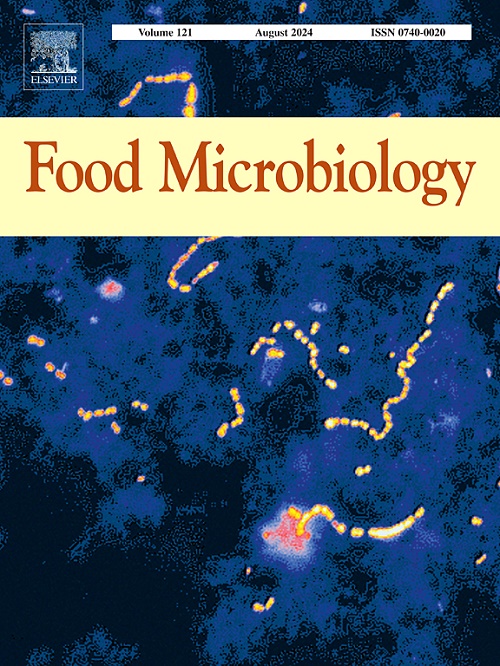Biocontrol potential of Streptomyces sp. N2 against green and blue mold disease in postharvest navel orange and the action mechanism
IF 4.5
1区 农林科学
Q1 BIOTECHNOLOGY & APPLIED MICROBIOLOGY
引用次数: 0
Abstract
The objective of this study was to provide a promising alternative to chemical fungicides for management of postharvest citrus decay, thereby promoting sustainable citrus fruit production. The postharvest decay of citrus fruit caused by Penicillium digitatum and Penicillium italicum results in substantial economic losses in citrus industry worldwide. With growing fungal resistance issues in P. digitatum and P. italicum, there is an urgent need for searching new methods to address above problems in a safe and environmentally friendly way. Streptomyces sp. N2, a new species from Streptomyces genus, exhibits significant antagonistic activity against Rhizoctonia solani. However, its biocontrol efficacy against postharvest decay caused by P. digitatum and P. italicum and its action mechanism remain unknown. In this study, Streptomyces sp. N2 was found to have significant potential in controlling green and blue mold diseases in postharvest navel oranges. Moreover, the action mechanism of Streptomyces sp. N2 against both P. italicum and P. digitatum was elucidated. On the one hand, Streptomyces sp. N2 stimulated fruit resistance to fight against invading fungal pathogens. It significantly reduced ROS content in navel orange upon the infection of mold disease, increased the production of defense-related enzymes including peroxidase (POD), polyphenol oxidase (PPO), and phenylalanine ammonia-lyase (PAL) and pathogenesis-related proteins of chitinase and β-1,3-glucanase. On the other hand, Streptomyces sp. N2 secreted bioactive substances to inhibit the growth of P. italicum and P. digitatum so as to prevent the development of postharvest decay. The bioactive substances secreted by Streptomyces sp. N2 significantly inhibited the spore germination and mycelial growth and led to microstructural damages to the cell wall and membrane, ROS burst, and mitochondrial dysfunction in both P. italicum and P. digitatum. This study provides a theoretical reference and application potential for the biological control of Streptomyces sp. N2 on green and blue mold diseases.
链霉菌 N2 对采后脐橙绿霉病和蓝霉病的生物防治潜力及作用机制
这项研究的目的是为柑橘采后腐烂的管理提供一种替代化学杀菌剂的可行方法,从而促进柑橘果实的可持续生产。由数字青霉(Penicillium digitatum)和意大利青霉(Penicillium italicum)引起的柑橘采后腐烂给全球柑橘产业造成了巨大的经济损失。随着数字青霉和意大利青霉的抗真菌性问题日益严重,迫切需要寻找新的方法,以安全、环保的方式解决上述问题。Streptomyces sp. N2 是链霉菌属的一个新物种,对根瘤菌具有显著的拮抗活性。然而,它对由 P. digitatum 和 P. italicum 引起的采后腐烂的生物防治效果及其作用机制仍不清楚。本研究发现,链霉菌 N2 在防治采后脐橙的绿霉病和蓝霉病方面具有显著的潜力。此外,还阐明了链霉菌 N2 对意大利脐橙霉菌和数字脐橙霉菌的作用机制。一方面,链霉菌 sp. N2 增强了果实的抵抗力,以对抗入侵的真菌病原体。一方面,链霉菌 sp. N2 能增强果实的抗病能力,在脐橙感染霉病时能明显降低 ROS 含量,增加过氧化物酶(POD)、多酚氧化酶(PPO)、苯丙氨酸氨解酶(PAL)等防御相关酶以及几丁质酶和β-1,3-葡聚糖酶等致病相关蛋白的产量。另一方面,链霉菌 N2 分泌的生物活性物质可抑制 P. italicum 和 P. digitatum 的生长,从而防止采后腐烂的发生。N2 链霉菌分泌的生物活性物质明显抑制了伊犁金丝桃和地肤金丝桃的孢子萌发和菌丝生长,并导致细胞壁和细胞膜的微结构损伤、ROS爆发和线粒体功能障碍。这项研究为链霉菌 N2 对绿霉病和蓝霉病的生物防治提供了理论参考和应用前景。
本文章由计算机程序翻译,如有差异,请以英文原文为准。
求助全文
约1分钟内获得全文
求助全文
来源期刊

Food microbiology
工程技术-生物工程与应用微生物
CiteScore
11.30
自引率
3.80%
发文量
179
审稿时长
44 days
期刊介绍:
Food Microbiology publishes original research articles, short communications, review papers, letters, news items and book reviews dealing with all aspects of the microbiology of foods. The editors aim to publish manuscripts of the highest quality which are both relevant and applicable to the broad field covered by the journal. Studies must be novel, have a clear connection to food microbiology, and be of general interest to the international community of food microbiologists. The editors make every effort to ensure rapid and fair reviews, resulting in timely publication of accepted manuscripts.
 求助内容:
求助内容: 应助结果提醒方式:
应助结果提醒方式:


